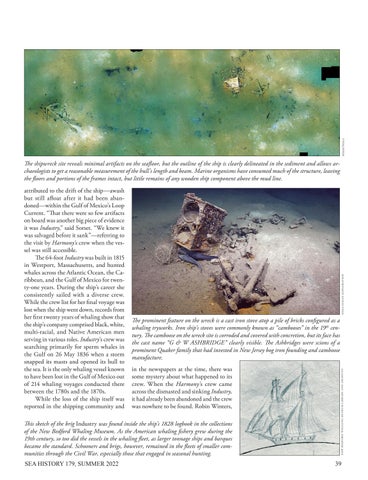boem/noaa
The prominent feature on the wreck is a cast iron stove atop a pile of bricks configured as a whaling tryworks. Iron ship’s stoves were commonly known as “cambooses” in the 19th century. The camboose on the wreck site is corroded and covered with concretion, but its face has the cast name “G & W ASHBRIDGE” clearly visible. The Ashbridges were scions of a prominent Quaker family that had invested in New Jersey bog iron founding and camboose manufacture. in the newspapers at the time, there was some mystery about what happened to its crew. When the Harmony’s crew came across the dismasted and sinking Industry, it had already been abandoned and the crew was nowhere to be found. Robin Winters,
This sketch of the brig Industry was found inside the ship’s 1828 logbook in the collections of the New Bedford Whaling Museum. As the American whaling fishery grew during the 19th century, so too did the vessels in the whaling fleet, as larger tonnage ships and barques became the standard. Schooners and brigs, however, remained in the fleets of smaller communities through the Civil War, especially those that engaged in seasonal hunting. SEA HISTORY 179, SUMMER 2022
new bedford whaling museum library and archives
attributed to the drift of the ship—awash but still afloat after it had been abandoned—within the Gulf of Mexico’s Loop Current. “That there were so few artifacts on board was another big piece of evidence it was Industry,” said Sorset. “We knew it was salvaged before it sank”—referring to the visit by Harmony’s crew when the vessel was still accessible. The 64-foot Industry was built in 1815 in Westport, Massachusetts, and hunted whales across the Atlantic Ocean, the Caribbean, and the Gulf of Mexico for twenty-one years. During the ship’s career she consistently sailed with a diverse crew. While the crew list for her final voyage was lost when the ship went down, records from her first twenty years of whaling show that the ship’s company comprised black, white, multi-racial, and Native American men serving in various roles. Industry’s crew was searching primarily for sperm whales in the Gulf on 26 May 1836 when a storm snapped its masts and opened its hull to the sea. It is the only whaling vessel known to have been lost in the Gulf of Mexico out of 214 whaling voyages conducted there between the 1780s and the 1870s. While the loss of the ship itself was reported in the shipping community and
noaa ocean exploration
The shipwreck site reveals minimal artifacts on the seafloor, but the outline of the ship is clearly delineated in the sediment and allows archaeologists to get a reasonable measurement of the hull’s length and beam. Marine organisms have consumed much of the structure, leaving the floors and portions of the frames intact, but little remains of any wooden ship component above the mud line.
39



